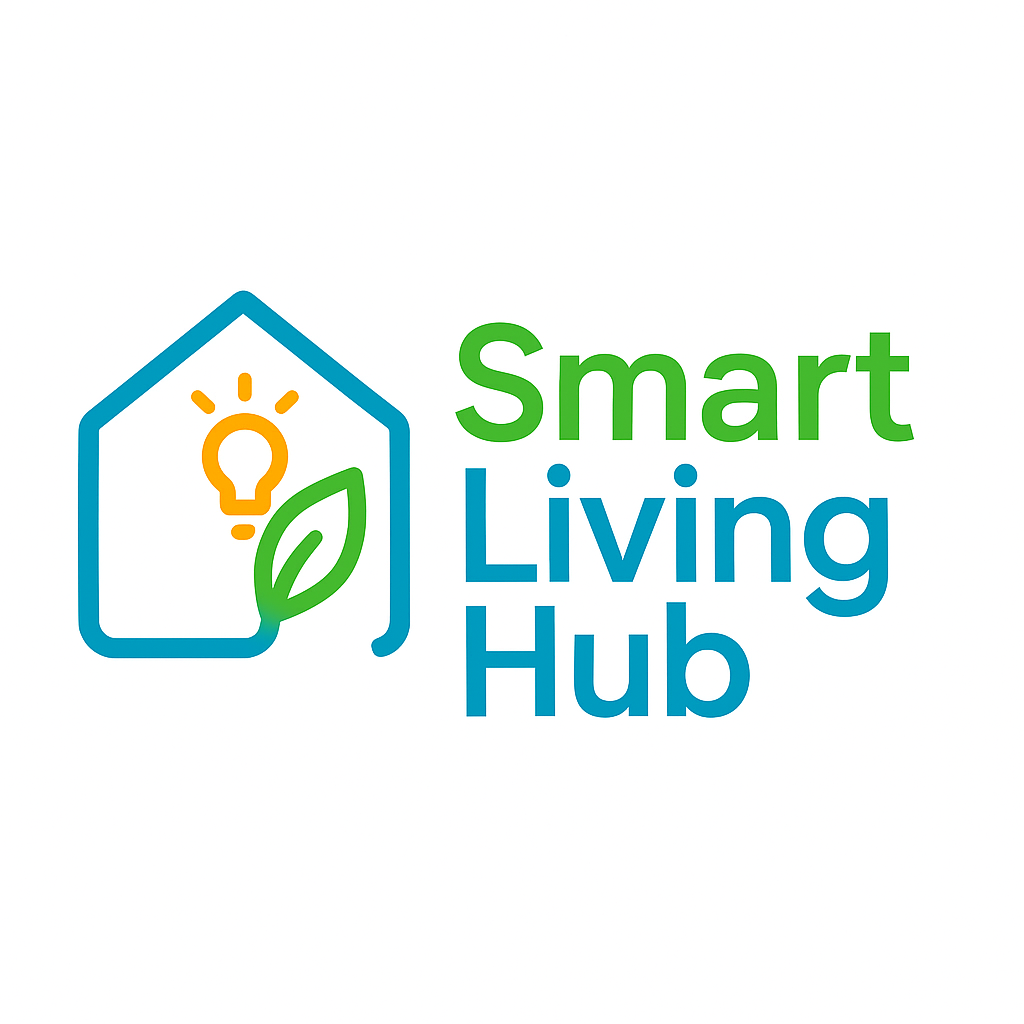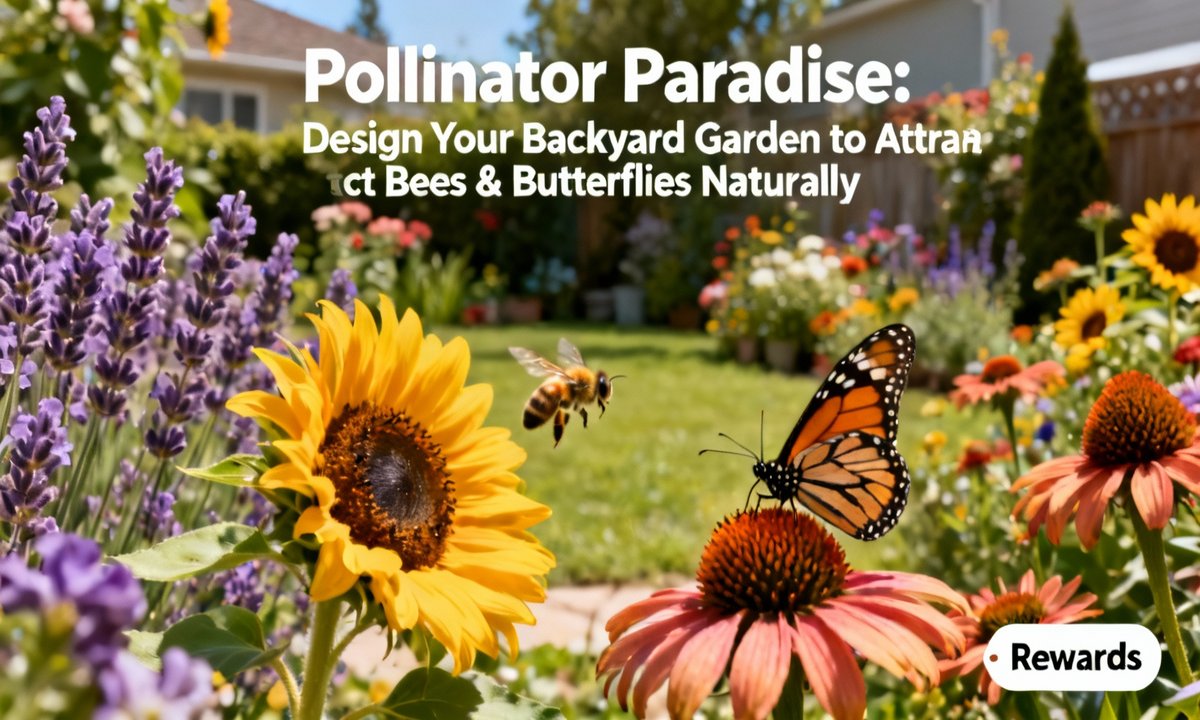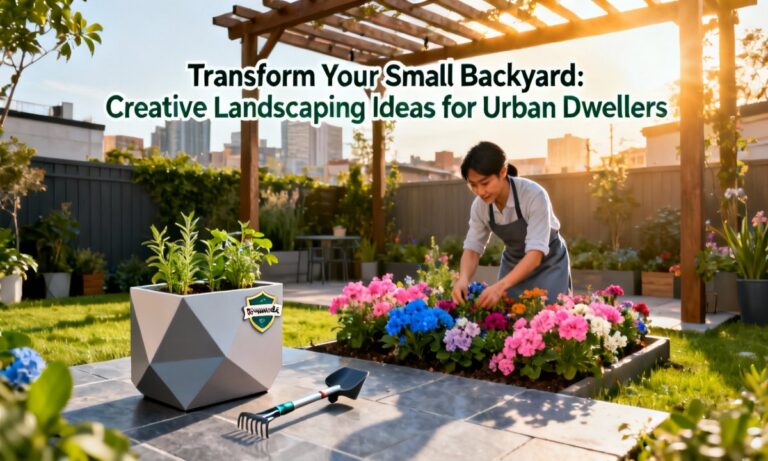Creating a pollinator garden transforms your yard into a living tapestry, playing a vital role in supporting the environment. Bees and butterflies are not only beautiful; they are essential to our food production and the overall health of ecosystems. By inviting these crucial pollinators into your outdoor space, you can enjoy vibrant blooms, support local biodiversity, and add a naturally chic touch to your home landscape.
Understanding Your Pollinator Paradise
What Defines a Pollinator Garden?
A pollinator garden is a thoughtfully designed space, rich with native plants for pollinators like wildflowers and herbs. These plants specifically attract and nourish bees, butterflies, and other helpful insects. Unlike traditional ornamental gardens, these spaces provide the vital resources creatures need to thrive and reproduce. Even a small area or a few containers can create a flourishing pollinator habitat.
The Vital Role of Bees and Butterflies
Welcoming bees and butterflies into your backyard offers significant benefits beyond visual appeal. Pollinators are fundamental to the reproduction of approximately one-third of all food crops, sustaining healthy ecosystems globally. Supporting them can increase your garden’s yield, improve plant health, and enhance local wildlife diversity. Witnessing the captivating process of pollination up-close turns your garden into an engaging nature classroom for everyone. You can learn more about their importance through sources like the USGS.
Beyond Beauty: Ecological and Aesthetic Rewards
A thriving pollinator garden provides an ecological win and is a continuous visual delight. Picture vibrant butterflies dancing over bee friendly plants, busy bees collecting nectar from abundant perennial flowers, and songbirds visiting for seeds. For those who appreciate stylish sustainability, our Eco-Chic Home guide offers further inspiration on green design that beautifully complements your garden.
Foundations of a Thriving Pollinator Habitat
Essential Principles for Pollinator-Friendly Design
To effectively create a thriving habitat for bees and butterflies, begin with fundamental guidelines recommended by pollinator experts. These principles ensure your garden provides optimal support for these vital insects, fostering a balanced and dynamic ecosystem. A comprehensive guide from Pollinator.org can offer detailed insights.
Selecting the Right Plants
Prioritize the selection of diverse native species that offer continuous nectar and pollen from spring through fall. It is crucial to match these species to your specific USDA hardiness zone and local climate. This ensures they thrive naturally, as detailed in plant lists from organizations like the Xerces Society.
Strategic Planting Techniques
When arranging your garden, group similar flowers in dense clusters. This technique helps pollinators locate and utilize resources more efficiently, maximizing their foraging efforts. Thoughtful placement supports a vibrant and active garden environment.
Creating Year-Round Shelter
Design your habitat with multiple layers, incorporating trees, shrubs, wildflowers, and ground cover. This variety provides essential shelter and food sources throughout the entire year, catering to different life stages of pollinators.
Embracing Organic Practices
Commit to a pesticide-free approach in your garden. Avoiding synthetic herbicides and pesticides is crucial, as these chemicals are highly detrimental to pollinators and overall garden health.
Discovering Ideal Native Plants
Top Choices for US Pollinator Gardens
The cornerstone of any successful pollinator paradise lies in careful plant selection. Consider these reliable pollinator plants, renowned for their ability to attract and sustain essential insects. For further insights, resources such as LawnStarter’s guide provide valuable information.
Milkweed (Asclepias spp.) serves as a vital host plant for Monarch butterflies, typically blooming from June to August. This species is notably drought-tolerant and plays a crucial role in the monarch’s life cycle.
Butterfly Weed (Asclepias tuberosa) enchants with its vibrant orange blooms, appearing from early summer into fall. It is a favorite nectar source for both butterflies and various bee species.
Purple Coneflower (Echinacea purpurea) is a resilient, sun-loving perennial. It provides a burst of mid- to late-summer color and is widely cherished by both bees and butterflies.
Black-Eyed Susan (Rudbeckia hirta) offers cheerful yellow flowers that grace the garden from June to September. This plant is known for its lively appearance and remarkable resilience.
Joe Pye Weed (Eutrochium purpureum) grows tall, preferring moist soils, and is particularly effective at attracting swallowtail butterflies. Its majestic blooms add significant height to a garden.
Blazing Star (Liatris spicata) produces striking purple spikes throughout the summer months. This adaptable plant exhibits a wide tolerance for various soil conditions, making it a versatile choice.
Mountain Mint (Pycnanthemum spp.) is an aromatic herb that is exceptionally attractive to a wide array of bees and butterflies. Its fragrant foliage and flowers are a true pollinator magnet.
Golden Alexanders (Zizia aurea) offers early nectar with its bright yellow blooms, typically appearing from April to June. It is a crucial early season food source for many emerging pollinators.
For more region-specific recommendations and to broaden your selection, explore plant lists from organizations like the Xerces Society, alongside guides on sustainable gardening.
Designing for Butterflies: Specific Elements
To create an irresistible magnet for butterflies and bees, integrate specific design elements into your garden. Pollinators generally prefer warmth, so select a sunny, sheltered spot within your yard. Strategic layering of plant heights, using raised beds, tall perennials, and low-growing ground covers, enhances both visual appeal and ecological function.
Introduce nectar-rich annuals such as zinnias or calendulas for continuous bursts of color throughout the season. Crucially, provide host plants, like milkweed for monarchs, to support the entire life cycle of butterflies.
Crafting Your Pollinator Garden: A Step-by-Step Approach
From Vision to Reality: Your Garden Blueprint
Designing a pollinator-friendly backyard can be a rewarding process when broken down into manageable steps. Start by observing your yard to identify the sunniest areas, then sketch a simple layout for your new garden. Remember, nature thrives on variety, so perfection is not the primary goal.
Prepare your soil by enriching it with organic matter, which supports healthy plant growth. It’s important to avoid using weed fabric, as this can hinder ground-nesting bees from accessing suitable nesting sites.
When selecting your plant palette, prioritize native wildflowers, beneficial herbs such as bee balm, and small shrubs. Group plants of the same type in clusters, ideally using three to five of each species, to create visible and efficient foraging areas for pollinators.
Arrange your plants thoughtfully: place the tallest varieties at the back of your garden beds or in the center if designing island beds. Layer forward with mid-height flowers, and frame the edges with low-growing ground covers to create visual depth and structure.
Water your newly planted garden thoroughly, especially when establishing perennials and during periods of dry weather. Proper hydration is critical for their initial growth and long-term health.
Apply mulch sparingly, ensuring you leave open spaces of bare ground. These untouched areas are vital for many species of ground-nesting bees, providing them with essential habitat.
Finally, offer a readily accessible water source. A shallow dish filled with pebbles provides a safe and essential drinking spot for various pollinators. For those new to DIY outdoor projects, our guide on Trendy DIY Home Decor Ideas can offer simple, hands-on inspiration.
Ingenious Ideas for Smaller Spaces
Even without a sprawling backyard, you can create a vibrant pollinator haven. Container pollinator gardens are remarkably effective and compact solutions for limited spaces. Consider pairing tall coreopsis or salvia in larger pots for striking vertical appeal.
In medium planters, combine milkweed and bee balm, providing essential resources for various pollinators. For container edges, trailing nasturtiums or creeping thyme add beauty and function. Herbs like lavender or oregano serve a dual purpose, acting as excellent pollinator food and culinary delights.
Apartment balconies or patios can easily transform into mini wildlife sanctuaries with thoughtful garden design ideas. The strategic placement of a few well-chosen native plants for pollinators, perhaps in raised beds or vertical planters, can maximize even the smallest footprints.
Nurturing Your Pollinator Haven
Sustaining Your Garden’s Vibrancy: Maintenance Tips
To keep your pollinator paradise thriving, consistent and mindful maintenance is key. Deadhead faded flowers on plants like coneflower, bee balm, and black-eyed Susan to encourage a continuous flush of new blooms throughout the season.
Limit extensive fall cleanup in your garden; leaving some stems and leaf litter provides crucial shelter for overwintering insects. Annually refresh your mulch using natural materials such as leaves or compost, but ensure the layer remains thin to allow open ground for vital bee nesting sites.
Regularly observe your garden to identify which plants attract the most pollinators, then adjust your plantings by adding more of these successful species each year to cultivate a stronger ecosystem. During periods of drought, hand water your plants, particularly new plantings and container pollinator gardens, to ensure their survival and health.
For ongoing savings and to embrace more sustainable home practices that complement your garden efforts, you may wish to review The Ultimate 2025 Frugal Living Guide.
Overcoming Common Garden Challenges
Addressing common mistakes can significantly improve the success of your pollinator garden. A frequent issue is relying on non-native ornamental plants, which often lack the specific nectar or habitat suitable for local pollinators.
Prioritizing Native Species
The solution is to consistently choose native species. These plants are inherently hardier and provide far more benefits for local bees and butterflies, as highlighted by resources like LawnStarter. They are naturally adapted to your region’s climate and soil, making them low-maintenance.
The Power of Organic Methods
Another common pitfall is the overuse of pesticides or herbicides. Instead, embrace robust organic gardening methods. Manual weed pulling, strategic mulching, and companion planting are safer, more effective solutions that protect your pollinators and the broader ecosystem.
Maximizing Pollinator Attraction
Avoid planting in sparse rows or with isolated plants, which can be less appealing to pollinators. For maximum attraction, always plant in dense clusters. This visual mass makes your garden more noticeable and efficient for foraging insects.
Integrating Beauty with Purpose
Blending Aesthetics and Ecological Function
A pollinator garden doesn’t just serve an ecological purpose; it can also be a truly gorgeous showpiece. By thoughtfully layering various plant heights, mixing vibrant colors, and artfully weaving in edible herbs, you can create intricate lines and textures. These design elements can beautifully echo the principles found in the finest eco-chic home decor.
With careful planning and attention to detail, your garden can deliver continuous blooms and enhance your home’s curb appeal from early spring all the way through late fall. To discover more ways to harmonize your interior and exterior green living spaces, explore our guides on sustainable home decor ideas and practical DIY home upgrades.
Adapting Your Garden Seasonally and Regionally
For optimal success, plants thrive best when they are perfectly matched to your specific geographical location. It is highly recommended to select native species that are indigenous to your state or ecoregion. You can find excellent resources for this, including the Pollinator.org Planting Guides and the Xerces Society Plant Lists, or by consulting local nurseries specializing in native seeds or plant starts.
To accurately determine USDA hardiness zones and appropriate planting times, always refer to reliable local guides or contact your university extension office. Utilizing seasonal planting calendars will help ensure a continuous display of flowers and resources for pollinators throughout the spring, summer, and fall months.
Expanding Your Wildlife Sanctuary
Attracting Diverse Wildlife Beyond Pollinators
While bees and butterflies often capture the spotlight, a thoughtfully designed wildlife garden can attract a broader array of fascinating creatures. This includes hummingbirds, beneficial predatory insects, and a variety of songbirds, enriching your outdoor space. Diverse plantings naturally lead to a richer ecosystem, which often results in fewer pests.
To further enhance habitat for a wider range of creatures, consider incorporating water features, cultivating berry-producing shrubs, and creating safe nesting spots. These can be subtly hidden within leafy thickets or constructed with natural log piles, providing essential refuge.
Common Questions About Pollinator Gardens
Many aspiring gardeners wonder if a pollinator garden will attract unwanted pests. Generally, these gardens primarily draw beneficial insects, and most additional creatures are either harmless or actively help in controlling plant pests, contributing to a balanced ecosystem.
The amount of space required is flexible, ranging from a single large container to an entire yard. Larger and denser groupings of plants typically enhance diversity and encourage more frequent pollinator visits, making every effort impactful.
You can absolutely blend pollinator plants with your existing landscaping. Many native perennials serve as stunning additions to flower beds or borders. When integrating them, remember to skip heavy mulch or weed barriers to ensure ground-nesting bees have access to suitable nesting areas.
Further Exploration and Resources
Dive Deeper: Recommended Readings
For those eager to deepen their understanding and expand their pollinator gardens, a wealth of resources is available. Explore the Pollinator.org Regional Planting Guides for tailored advice. The Xerces Society Pollinator-Friendly Plant Lists offer comprehensive plant suggestions. You can also find valuable insights from the NPS Gardening for Pollinators, and discover specialized knowledge in Bee & Pollinator Books.
With planning, patience, and a touch of creativity, anyone can cultivate a backyard garden that welcomes bees and butterflies. Whether it’s a few containers on a balcony or a sprawling wildflower meadow, every effort genuinely supports local wildlife and brings natural beauty closer to home. Allow these gardening tips to serve as your foundation, and then let your creativity blossom.
Consider integrating other eco-friendly home upgrades by exploring our Eco-Chic Home Decor suggestions. Additionally, discover the financial and environmental benefits of creating natural, low-maintenance landscapes with The Ultimate 2025 Frugal Living Guide. Start modestly—perhaps with a patch of milkweed near your porch or a cluster of bee balm in a raised bed. Soon, you will be rewarded with the enchanting sight of monarchs gliding and bees buzzing among abundant blooms, a beautiful celebration of nature right at your doorstep.


